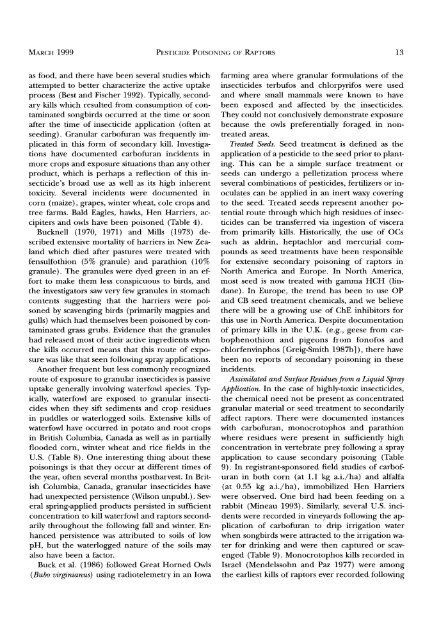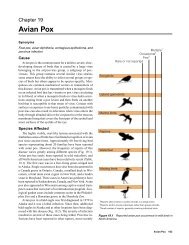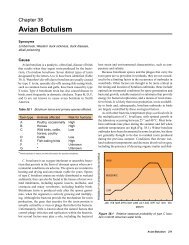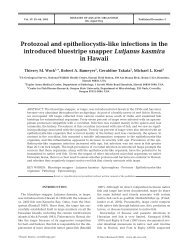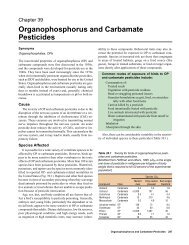poisoning of raptors with organophosphorus and carbamate ...
poisoning of raptors with organophosphorus and carbamate ...
poisoning of raptors with organophosphorus and carbamate ...
Create successful ePaper yourself
Turn your PDF publications into a flip-book with our unique Google optimized e-Paper software.
]VkARCH 1999 PESTICIDE POISONING OF RAPTORS 13<br />
as food, <strong>and</strong> there have been several studies which<br />
attempted to better characterize the active uptake<br />
process (Best <strong>and</strong> Fischer 1992). Typically, secondary<br />
kills which resulted from consumption <strong>of</strong> contaminated<br />
songbirds occurred at the time or soon<br />
after the time <strong>of</strong> insecticide application (<strong>of</strong>ten at<br />
seeding). Granular carb<strong>of</strong>uran was frequently implicated<br />
in this form <strong>of</strong> secondary kill. Investigations<br />
have documented carb<strong>of</strong>uran incidents in<br />
more crops <strong>and</strong> exposure situations than any other<br />
product, which is perhaps a reflection <strong>of</strong> this insecticide's<br />
broad use as well as its high inherent<br />
toxicity. Several incidents were documented in<br />
corn (maize), grapes, winter wheat, cole crops <strong>and</strong><br />
tree farms. Bald Eagles, hawks, Hen Harriers, ac~<br />
cipiters <strong>and</strong> owls have been poisoned (Table 4).<br />
Bucknell (1970, 1971) <strong>and</strong> Mills (1973) described<br />
extensive mortality <strong>of</strong> harriers in New Zeal<strong>and</strong><br />
which died after pastures were treated <strong>with</strong><br />
fensulfothion (5% granule) <strong>and</strong> parathion (10%<br />
granule). The granules were dyed green in an effort<br />
to make them less conspicuous to birds, <strong>and</strong><br />
the investigators saw very few granules in stomach<br />
contents suggesting that the harriers were poisoned<br />
by scavenging birds (primarily magpies <strong>and</strong><br />
gulls) which had themselves been poisoned by contaminated<br />
grass grubs. Evidence that the granules<br />
had released most <strong>of</strong> their active ingredients when<br />
the kills occurred means that this route <strong>of</strong> exposure<br />
was like that seen following spray applications.<br />
Another frequent but less commonly recognized<br />
route <strong>of</strong> exposure to granular insecticides is passive<br />
uptake generally involving waterfowl species. Typically,<br />
waterfowl are exposed to granular insecticides<br />
when they sift sediments <strong>and</strong> crop residues<br />
in puddles or waterlogged soils. Extensive kills <strong>of</strong><br />
waterfowl have occurred in potato <strong>and</strong> root crops<br />
in British Columbia, Canada as well as in partially<br />
flooded corn, winter wheat <strong>and</strong> rice fields in the<br />
U.S. (Table 8). One interesting thing about these<br />
<strong>poisoning</strong>s is that they occur at different times <strong>of</strong><br />
the year, <strong>of</strong>ten several months postharvest. In British<br />
Columbia, Canada, granular insecticides have<br />
had unexpected persistence (Wilson unpubl.). Several<br />
spring-applied products persisted in sufficient<br />
concentration to kill waterfowl <strong>and</strong> <strong>raptors</strong> secondarily<br />
throughout the following fall <strong>and</strong> winter. Enhanced<br />
persistence was attributed to soils <strong>of</strong> low<br />
pH, but the waterlogged nature <strong>of</strong> the soils may<br />
also have been a factor.<br />
Buck et al. (1986) followed Great Horned Owls<br />
(Bubo virginianus) using radiotelemetry in an Iowa<br />
farming area where granular formulations <strong>of</strong> the<br />
insecticides terbufos <strong>and</strong> chlorpyrifos were used<br />
<strong>and</strong> where small mammals were known to have<br />
been exposed <strong>and</strong> affected by the insecticides.<br />
They could not conclusively demonstrate exposure<br />
because the owls preferentially foraged in nontreated<br />
areas.<br />
Treated Seeds. Seed treatment is defined as the<br />
application <strong>of</strong> a pesticide to the seed prior to planting.<br />
This can be a simple surface treatment or<br />
seeds can undergo a pellefizafion process where<br />
several combinations <strong>of</strong> pesticides, fertilizers or inoculates<br />
can be applied in an inert waxy covering<br />
to the seed. Treated seeds represent another potential<br />
route through which high residues <strong>of</strong> insecticides<br />
can be transferred via ingestion <strong>of</strong> viscera<br />
from primarily kills. Historically, the use <strong>of</strong> OCs<br />
such as aldrin, heptachlor <strong>and</strong> mercurial compounds<br />
as seed treatments have been responsible<br />
for extensive secondary <strong>poisoning</strong> <strong>of</strong> <strong>raptors</strong> in<br />
North America <strong>and</strong> Europe. In North America,<br />
most seed is now treated <strong>with</strong> gamma HCH dindane).<br />
In Europe, the trend has been to use OP<br />
<strong>and</strong> CB seed treatment chemicals, <strong>and</strong> we believe<br />
there will be a growing use <strong>of</strong> ChE inhibitors for<br />
this use in North America. Despite documentation<br />
<strong>of</strong> primary kills in the U.K. (e.g., geese from carbophenothion<br />
<strong>and</strong> pigeons from fon<strong>of</strong>os <strong>and</strong><br />
chlorfenvinphos [Greig~Smith 1987b]), there have<br />
been no reports <strong>of</strong> secondary <strong>poisoning</strong> in these<br />
incidents.<br />
Assimilated <strong>and</strong> Surface Residues from a Liquid Spray<br />
Application. In the case <strong>of</strong> highly-toxic insecticides,<br />
the chemical need not be present as concentrated<br />
granular material or seed treatment to secondarily<br />
affect <strong>raptors</strong>. There were documented instances<br />
<strong>with</strong> carb<strong>of</strong>uran, monocrotophos <strong>and</strong> parathion<br />
where residues were present in sufficiently high<br />
concentration in vertebrate prey following a spray<br />
application to cause secondary <strong>poisoning</strong> (Table<br />
9). In registrant-sponsored field studies <strong>of</strong> carb<strong>of</strong>uran<br />
in both corn (at 1.1 kg a.i.?ha) <strong>and</strong> alfalfa<br />
(at 0.55 kg a.i.?ha), immobilized Hen Harriers<br />
were observed. One bird had been feeding on a<br />
rabbit (Mineau 1993). Similarly, several U.S. incidents<br />
were recorded in vineyards following the application<br />
<strong>of</strong> carb<strong>of</strong>uran to drip irrigation water<br />
when songbirds were attracted to the irrigation water<br />
for drinking <strong>and</strong> were then captured or scavenged<br />
(Table 9). Monocrotophos kills recorded in<br />
Israel (Mendelssohn <strong>and</strong> Paz 1977) were among<br />
the earliest kills <strong>of</strong> <strong>raptors</strong> ever recorded following


